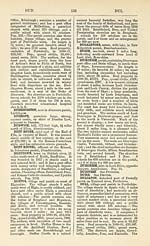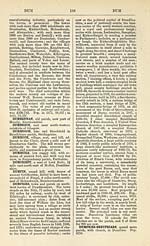Gazetteer of Scotland
(147) Page 137
Download files
Complete book:
Individual page:
Thumbnail gallery: Grid view | List view

DUL
137
DUM
surface comprises every variety from wild
portions of the Grampians to exquisite
portion of the Tay's valley ; and is diver-
sified by so many as 21 lakes. The seats
are Grandtully, Foss, Moness, Cluny, and
Dercluich ; and the antiquities include
several standing-stones, moats, barrows,
and Piet ; sh forts, and an ancient Cale-
donian stone circle. Churches of various
denominations are at Aberfeldy, Amulree,
Grandtully, and Tummel - Bridge ; and
public schools are at Amulree, Grandtully,
and Foss.
DULLARY, place, with chalybeate
spring, in Parton parish, Kirkcudbright-
shire.
DULLATUR, bog, traversed by Forth
and Clyde Canal, 2 miles east of Kilsyth,
Stirlingshire. Many relics of the battle of
Kilsyth in 1645 were found in it at the
forming of the canal.
DULLEN, rivulet in Mortlach parish,
Banffshire.
DULNAIN, river, running about 25
miles north-eastward to the Spey, at 2J
miles above Grantown, in Elginshire.
DULNAIN BRIDGE, hamlet on the Dul-
nain, in Duthil parish, Inverness-shire.
It has a post office under Grantown.
DULSIE BRIDGE, romantic bridge on
Findhorn river, in Ardclach parish, Nairn-
shire.
DUMBARNIE. See Dunbarnet.
DUMBARTON, town, castle, and parish
in Dumbartonshire. The town stands on
low flat ground, bisected by the river
Leven, f mile from the Clyde, and 15J
miles north - west - by - west of Glasgow ;
covers the site of the Roman naval station
Theodosia, and the site of a Culdee cell ;
shared in the history of Dumbarton Castle
as the royal seat of the kingdom of Cum-
bria or Strathclyde ; is now a seaport, a
royal and parliamentary burgh, and the
political capital of Dumbartonshire ; unites
with Port-Glasgow, Renfrew, Rutherglen,
and Kdmarnock in sending a member to
Parliament ; comprises a main body on the
left bank of the Leven, and two suburbs,
old and new, on the right bank ; was
designed in 1876 to undergo extensive im-
provements in its streets and harbour, and
in 1S81 to acquire an eastern suburb with
house accommodation for about 2000
families ; was long distinguished for glass
manufacture, and is much more dis-
tinguished now for shipbuilding; pub-
lishes 2 weekly newspapers ; and has a
head post office with money order and
telegraph departments, a railway station,
3 banking offices, 2 hotels, a fine town hall
of 1865, a long costly pier of 1874-75, a
steepled Established church of 1S10, a
handsome Free church of 1878, another
Free church, 2 United Presbyterian
churches, an elegant Episcopalian church
of 1873, Evangelical Union, Baptist, Wes-
leyan, and Roman Catholic churches, a
Mechanics' Institute, and 7 public schools
with accommodation for 1961 scholars.
Real property in 1880-81, £43,842. Pop.
13,786. — The castle stands at left side of
the Leven's influx to the Clyde ; is an
isolated, precipitous, bi forked rock, about
a mile in girth at the base, and 260 feet
high, partially edificed with ramparts and
houses ; was a stronghold probably of the
Romans, and certainly of the Romanized
Strathclyde Caledonians ; has been a
royal fort from commencement of the
Scoto-Saxon monarchy till the present
time ; figured much and often in national
affairs till final fall of Queen Mary ; was
bereft of most of its military value by the
invention of modern artillery ; and, but for
a stipulation at the national union for
its being permanently maintained, might
have long ago been entirely relinquished
as a fort. — The parish excludes the town's
suburbs, measures about 7i by 3| miles, and
comprises 8291 acres. Real property of
landward part in 1880-81, £38,820. Pop,
10,898. The land for some distance from
the town and castle is low and flat, but
about the middle rises steeply into the
Lennox Hills, and in the farther end is
bleakly moorish. No school is in the
landward part, and 1 of the schools in the
town for 350 scholars is new.
DUMBARTONSHIRE, county, partly
maritime but principally inland, in west
of Scotland. It comprises a main body
and a detached district ; and it is high-
land in the one end, lowland in the
other end, and a rich mixture of the
two in the centre. The main body begins
around the head of Loch Lomond ; includes
that lake's west side and foot, and all the
country thence to Loch Long, the Clyde,
and the Endrick ; goes eastward on the
Clyde and among the Lennox Hills to
Kelvin river, at a point 3J miles north-
west of Glasgow ; and is 35 miles long, and
from 2 to 15 miles broad. The detached
district commences at 3f miles east of
nearest part of the main body ; extends
east - by - northward along the strath of
Forth and Clyde Canal ; was annexed to
the county in the time of Robert I. ; and
is 13 miles long, and from If mile to 4J
miles broad. The entire area is 270 square
miles. The surface ranges from grandly
mountainous westward of Loch Lomond,
to tamely flat along the Forth and Clyde
Canal. The rocks range from the meta-
moi'phic to the carboniferous, and include
roofing-slate and abundance of coal, lime-
stone, and building stone. The maritime
waters are Loch Long and the Firth of
Clyde on the boundary, and Gareloch
in the interior. The fresh-water lakes,
apart from Loch Lomond, are all small,
but an interesting one of them is Loch
Sloy. The chief rivers are the Endrick,
the Clyde, and the Kelvin on the boun-
daries ; and the Leven and the Allander
in the interior ; but many of the smaller
streams, especially those among the moun-
tains, possess much scenic character. Ag-
riculture is advanced and skilful ; and
137
DUM
surface comprises every variety from wild
portions of the Grampians to exquisite
portion of the Tay's valley ; and is diver-
sified by so many as 21 lakes. The seats
are Grandtully, Foss, Moness, Cluny, and
Dercluich ; and the antiquities include
several standing-stones, moats, barrows,
and Piet ; sh forts, and an ancient Cale-
donian stone circle. Churches of various
denominations are at Aberfeldy, Amulree,
Grandtully, and Tummel - Bridge ; and
public schools are at Amulree, Grandtully,
and Foss.
DULLARY, place, with chalybeate
spring, in Parton parish, Kirkcudbright-
shire.
DULLATUR, bog, traversed by Forth
and Clyde Canal, 2 miles east of Kilsyth,
Stirlingshire. Many relics of the battle of
Kilsyth in 1645 were found in it at the
forming of the canal.
DULLEN, rivulet in Mortlach parish,
Banffshire.
DULNAIN, river, running about 25
miles north-eastward to the Spey, at 2J
miles above Grantown, in Elginshire.
DULNAIN BRIDGE, hamlet on the Dul-
nain, in Duthil parish, Inverness-shire.
It has a post office under Grantown.
DULSIE BRIDGE, romantic bridge on
Findhorn river, in Ardclach parish, Nairn-
shire.
DUMBARNIE. See Dunbarnet.
DUMBARTON, town, castle, and parish
in Dumbartonshire. The town stands on
low flat ground, bisected by the river
Leven, f mile from the Clyde, and 15J
miles north - west - by - west of Glasgow ;
covers the site of the Roman naval station
Theodosia, and the site of a Culdee cell ;
shared in the history of Dumbarton Castle
as the royal seat of the kingdom of Cum-
bria or Strathclyde ; is now a seaport, a
royal and parliamentary burgh, and the
political capital of Dumbartonshire ; unites
with Port-Glasgow, Renfrew, Rutherglen,
and Kdmarnock in sending a member to
Parliament ; comprises a main body on the
left bank of the Leven, and two suburbs,
old and new, on the right bank ; was
designed in 1876 to undergo extensive im-
provements in its streets and harbour, and
in 1S81 to acquire an eastern suburb with
house accommodation for about 2000
families ; was long distinguished for glass
manufacture, and is much more dis-
tinguished now for shipbuilding; pub-
lishes 2 weekly newspapers ; and has a
head post office with money order and
telegraph departments, a railway station,
3 banking offices, 2 hotels, a fine town hall
of 1865, a long costly pier of 1874-75, a
steepled Established church of 1S10, a
handsome Free church of 1878, another
Free church, 2 United Presbyterian
churches, an elegant Episcopalian church
of 1873, Evangelical Union, Baptist, Wes-
leyan, and Roman Catholic churches, a
Mechanics' Institute, and 7 public schools
with accommodation for 1961 scholars.
Real property in 1880-81, £43,842. Pop.
13,786. — The castle stands at left side of
the Leven's influx to the Clyde ; is an
isolated, precipitous, bi forked rock, about
a mile in girth at the base, and 260 feet
high, partially edificed with ramparts and
houses ; was a stronghold probably of the
Romans, and certainly of the Romanized
Strathclyde Caledonians ; has been a
royal fort from commencement of the
Scoto-Saxon monarchy till the present
time ; figured much and often in national
affairs till final fall of Queen Mary ; was
bereft of most of its military value by the
invention of modern artillery ; and, but for
a stipulation at the national union for
its being permanently maintained, might
have long ago been entirely relinquished
as a fort. — The parish excludes the town's
suburbs, measures about 7i by 3| miles, and
comprises 8291 acres. Real property of
landward part in 1880-81, £38,820. Pop,
10,898. The land for some distance from
the town and castle is low and flat, but
about the middle rises steeply into the
Lennox Hills, and in the farther end is
bleakly moorish. No school is in the
landward part, and 1 of the schools in the
town for 350 scholars is new.
DUMBARTONSHIRE, county, partly
maritime but principally inland, in west
of Scotland. It comprises a main body
and a detached district ; and it is high-
land in the one end, lowland in the
other end, and a rich mixture of the
two in the centre. The main body begins
around the head of Loch Lomond ; includes
that lake's west side and foot, and all the
country thence to Loch Long, the Clyde,
and the Endrick ; goes eastward on the
Clyde and among the Lennox Hills to
Kelvin river, at a point 3J miles north-
west of Glasgow ; and is 35 miles long, and
from 2 to 15 miles broad. The detached
district commences at 3f miles east of
nearest part of the main body ; extends
east - by - northward along the strath of
Forth and Clyde Canal ; was annexed to
the county in the time of Robert I. ; and
is 13 miles long, and from If mile to 4J
miles broad. The entire area is 270 square
miles. The surface ranges from grandly
mountainous westward of Loch Lomond,
to tamely flat along the Forth and Clyde
Canal. The rocks range from the meta-
moi'phic to the carboniferous, and include
roofing-slate and abundance of coal, lime-
stone, and building stone. The maritime
waters are Loch Long and the Firth of
Clyde on the boundary, and Gareloch
in the interior. The fresh-water lakes,
apart from Loch Lomond, are all small,
but an interesting one of them is Loch
Sloy. The chief rivers are the Endrick,
the Clyde, and the Kelvin on the boun-
daries ; and the Leven and the Allander
in the interior ; but many of the smaller
streams, especially those among the moun-
tains, possess much scenic character. Ag-
riculture is advanced and skilful ; and
Set display mode to: Large image | Transcription
Images and transcriptions on this page, including medium image downloads, may be used under the Creative Commons Attribution 4.0 International Licence unless otherwise stated. ![]()
| Gazetteers of Scotland, 1803-1901 > Gazetteer of Scotland > (147) Page 137 |
|---|
| Permanent URL | https://digital.nls.uk/97356985 |
|---|

